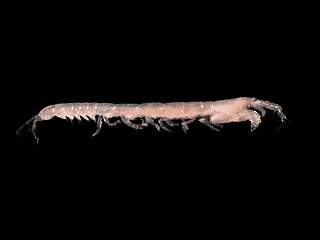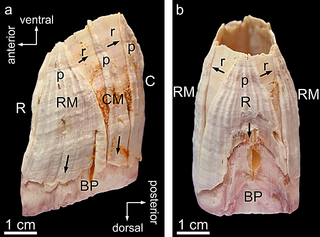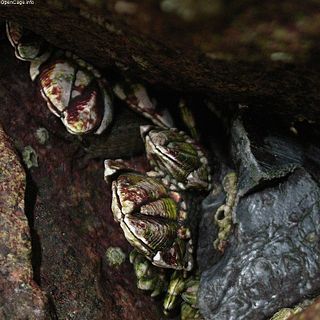
Dendrobranchiata is a suborder of decapods, commonly known as prawns. There are 540 extant species in seven families, and a fossil record extending back to the Devonian. They differ from related animals, such as Caridea and Stenopodidea, by the branching form of the gills and by the fact that they do not brood their eggs, but release them directly into the water. They may reach a length of over 330 millimetres (13 in) and a mass of 450 grams (1.0 lb), and are widely fished and farmed for human consumption.

Barnacles are arthropods of the subclass Cirripedia in the subphylum Crustacea. They are related to crabs and lobsters, with similar nauplius larvae. Barnacles are exclusively marine invertebrates; many species live in shallow and tidal waters. Some 2,100 species have been described.

Derocheilocarididae is a family of marine crustaceans that form part of the meiobenthos. It is the only family in the monotypic order Mystacocaridida, and the monotypic subclass Mystacocarida. These mystacocarids are less than 1 mm (0.04 in) long, and live interstitially in the intertidal zones of sandy beaches.

Malacostraca is the second largest of the six classes of pancrustaceans just behind hexapods, containing about 40,000 living species, divided among 16 orders. Its members, the malacostracans, display a great diversity of body forms and include crabs, lobsters, crayfish, shrimp, krill, prawns, woodlice, amphipods, mantis shrimp, tongue-eating lice and many other less familiar animals. They are abundant in all marine environments and have colonised freshwater and terrestrial habitats. They are segmented animals, united by a common body plan comprising 20 body segments, and divided into a head, thorax, and abdomen.

Isopoda is an order of crustacean, which includes woodlice and their relatives. Members of this group are called Isopods and include both terrestrial and aquatic species. All have rigid, segmented exoskeletons, two pairs of antennae, seven pairs of jointed limbs on the thorax, and five pairs of branching appendages on the abdomen that are used in respiration. Females brood their young in a pouch under their thorax.

Rhizocephala are derived barnacles that are parasitic castrators. Their hosts are mostly decapod crustaceans, but include Peracarida, mantis shrimps and thoracican barnacles. Their habitats range from the deep ocean to freshwater. Together with their sister groups Thoracica and Acrothoracica, they make up the subclass Cirripedia. Their body plan is uniquely reduced in an extreme adaptation to their parasitic lifestyle, and makes their relationship to other barnacles unrecognisable in the adult form. The name Rhizocephala derives from the Ancient Greek roots ῥίζα and κεφαλή, describing the adult female, which mostly consists of a network of thread-like extensions penetrating the body of the host.

The Cephalocarida are a class in the subphylum Crustacea comprising only 12 species. Both the nauplii and the adults are benthic. They were discovered in 1955 by Howard L. Sanders, and are commonly referred to as horseshoe shrimp. They have been grouped together with the Remipedia in the Xenocarida. Although a second family, Lightiellidae, is sometimes used, all cephalocaridans are generally considered to belong in just one family: Hutchinsoniellidae. Fossil records of cephalocaridans has been found in 462 million year old deposits.

The crustacean order Tanaidacea make up a minor group within the class Malacostraca. There are about 940 species in this order.

Thecostraca is a class of marine invertebrates containing over 2,200 described species. Many species have planktonic larvae which become sessile or parasitic as adults.

Semibalanus balanoides is a common and widespread boreo-arctic species of acorn barnacle. It is common on rocks and other substrates in the intertidal zone of north-western Europe and both coasts of North America.

Whale barnacles are species of acorn barnacle that belong to the family Coronulidae. They typically attach to baleen whales, and sometimes settle on toothed whales. The whale barnacles diverged from the turtle barnacles about three million years ago.

Ascothoracida is a small group of parasitic marine crustaceans, comprising around 100 species and divided into Dendrogastrida and Laurida. They are found throughout the world on cnidarians and echinoderms. Dendrogastrida are parasites on echinoderms, and Laurida are parasites on cnidarians, except from the species Waginella Grygier, which is also a parasite on echinoderms (crinoids). Piercing and sucking mouthparts are used for feeding, and more advanced forms also absorbs nutrients through a modified integument of the carapace. More basal forms are ectoparasitic, but most genera are meso- and endoparasitic. The sexes are separate, except from secondary hermaphroditic species of the Petrarcidae. In many species the larger female often have smaller males living inside her mantle cavity.

Austromegabalanus psittacus, the giant barnacle or picoroco as it is known in Spanish, is a species of large barnacle native to the coasts of southern Peru, all of Chile and southern Argentina. It inhabits the littoral and intertidal zones of rocky shores and normally grows up to 30 centimetres (12 in) tall with a mineralized shell composed of calcite. The picoroco barnacle is used in Chilean cuisine and is one of the ingredients in curanto.

Facetotecta is a poorly known subclass of thecostracan crustaceans. The adult forms have never been recognised, and the group is known only from its larvae, the "y-nauplius" and "y-cyprid" larvae. They are mostly found in the north Atlantic Ocean, neritic waters around Japan, and the Mediterranean Basin, where they also survive in brackish water.

Crustaceans may pass through a number of larval and immature stages between hatching from their eggs and reaching their adult form. Each of the stages is separated by a moult, in which the hard exoskeleton is shed to allow the animal to grow. The larvae of crustaceans often bear little resemblance to the adult, and there are still cases where it is not known what larvae will grow into what adults. This is especially true of crustaceans which live as benthic adults, more-so than where the larvae are planktonic, and thereby easily caught.

Lepas anserifera is a species of goose barnacle or stalked barnacle in the family Lepadidae. It lives attached to floating timber, ships' hulls and various sorts of flotsam.

Pollicipes polymerus, commonly known as the gooseneck barnacle or leaf barnacle, is a species of stalked barnacle. It is found, often in great numbers, on rocky shores on the Pacific coasts of North America.

Capitulum is a monotypic genus of sessile marine stalked barnacles. Capitulum mitella is the only species in the genus. It is commonly known as the Japanese goose barnacle or kamenote and is found on rocky shores in the Indo-Pacific region.

Crustaceans are a group of arthropods that are a part of the subphylum Crustacea, a large, diverse group of mainly aquatic arthropods including decapods, seed shrimp, branchiopods, fish lice, krill, remipedes, isopods, barnacles, copepods, opossum shrimps, amphipods and mantis shrimp. The crustacean group can be treated as a subphylum under the clade Mandibulata. It is now well accepted that the hexapods emerged deep in the Crustacean group, with the completed group referred to as Pancrustacea. The three classes Cephalocarida, Branchiopoda and Remipedia are more closely related to the hexapods than they are to any of the other crustaceans.
Cryptophialidae is a family of Acrothoracican barnacles in the order Cryptophialida, the sole family of the order. There are at least 2 genera and more than 20 described species in Cryptophialidae. These barnacles burrow into calcareous rocks and structures, such as limestone, shells, or corals.



















